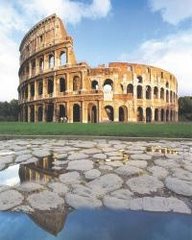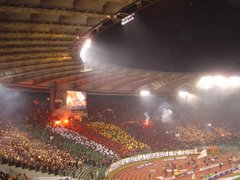The historic Squares
This itinerary can start from nowhere else but the Piazza del Campidoglio situated on the Capitoline Hill, which has always been the privileged seat of divinity and power.
Although it is the lowest and least extensive of the Seven Hills of Rome, in the early 6th century B.C. there stood the Temple of Jupiter Optimus Maximus Capitolinus, by far the most important temple of ancient Rome. Near the present-day church of Santa Maria in Ara Coeli was, instead, the Temple of Juno Moneta.
It was precisely in the Temple of Juno Moneta, i.e. "exhorter, admonisher", that the first mint of Rome was established, and the goddess's epithet later gave rise to the Italian word "moneta", to mean "coin".
In 390 B.C. the Gauls, commanded by King Brennus, stormed into Rome, crossing the Capitoline Hill, but the sacred geese of Juno, kept here, started squawking. The Romans, awakened by the noise of the animals, were thus able to repel the assailants.
During the Middle Ages the summit of the hill, partially abandoned, leading it to be called Monte Caprino after the goats grazing there, was the site of a marketplace.
In the market the measure for wine was the inside of an ancient column drum, while that for wheat (the ruggitella) was the urn of the ashes of the Empress Agrippina.
The square, as an actual urbanistic element, was created only starting in 1538, when Pope Paul III entrusted its arrangement to Michelangelo. Michelangelo designed the lovely star-shaped pavement pattern, the façade of the Palazzo Senatorio, the seat of the City of Rome since 1143, and the two palaces embracing the square, today the renovated seat of the Capitoline Museums, the oldest museums in the world.
The equestrian statue of Marcus Aurelius, of which a faithful copy can be seen in the centre of the square and the original is in the museums, managed to pass unharmed through the Middle Ages, a period when metals were melted down and reused, only thanks to a misunderstanding: the popes, who were its owners until the 15th century, had identified the person depicted as Constantine, the first Christian emperor. Legend has it that when the screech-owl between the horse's ears will hoot, the end of the world will arrive. This event seems to be very far off, however, considering that the owl is, in reality, a tuft of the horse's mane!
A new passageway connects Piazza del Campidoglio to the Terraces of the Vittoriano which offer a breath taking view of the city. The monument, devoted to the first king of Italy Victor Emmanuel II, and, since 1921, to the Unknow Soldier, includes the Museum of the Risorgimento and the Sanctuary of the Flags. It is entirely accessible to the public.
At the foot of the Capitoline Hill opens out Piazza Venezia, which takes its name from the monumental palace ordered by Pope Paul II, who was of Venetian origin, in the mid-15th century.
In 1929, when Palazzo Venezia became the seat of the head of the Government, the square was proclaimed "Forum of Italy", becoming the true centre of the city. One side of the square is dominated by the theatrical backdrop of the Vittoriano. The construction of the building unfortunately carried with it the total destruction of the pre-existing medieval and Renaissance quarter where Michelangelo had lived until his death.
From Piazza Venezia it is possible to reach fairly quickly, going down a stretch of the Via del Corso, Piazza Colonna, thus named after the 2nd-century marble column celebrating the victories of the Emperor Marcus Aurelius over the Germanic populations.
The column escaped destruction because during the Middle Ages the little Benedictine church of Sant'Andrea was built against it. It was possible to go up to the little terrace at the top, using the internal staircase, on payment of a fee. From there, where the statues of Marcus Aurelius and Faustina were once situated, the pilgrims could admire a vast panorama.
The square was the site of the papal post office, a place of famous cafés, and famous band concerts. At present it is the centre of the Italian political life, which gravitates around Palazzo Chigi, the seat of the Prime Minister.
From Piazza Colonna we can go, passing in front of Palazzo Montecitorio, seat of the Parliament of the Republic, towards the Piazza called della Rotonda which takes its name from the unmistakable structure of the Pantheon.
The Pantheon is the building of ancient Rome which has been preserved best down to the present day, and is a true masterpiece of architecture. The name of Agrippa, which can still be read on the façade, remembers the son-in-law of the Emperor Augustus, who first built this temple dedicated "to all the gods". The present-day Pantheon however, completely different from the original, is the work of the Emperor Hadrian, who rebuilt the monument in the early 2nd century, keeping only the ancient inscription out of modesty.
In the 6th century the Byzantine emperor Phocas gave the building to Pope Boniface IV, who turned it into the present church of Sancta Maria ad Martyres.
For the solemn consecration of the church, the pope had 28 cartloads of bones of martyrs brought from the catacombs, putting them underneath the altar. During the ceremony, as the notes of the Gloria were struck, the Romans saw swarms of devils rise up and fly out the hole in the dome.
The most amazing characteristic of the building is the exceptional covering dome. It is the largest dome ever created out of concrete: it measures 43.30 m in diameter and is greater than that of the dome of St. Peter's!
The entire building is conceived as a perfect geometric figure: a sphere inserted in a cylinder. The diameter of the sphere coincides with the height of the cylinder. The dome, created with different materials, increasingly lighter as they go upwards, ends with a large open "eye", of a diameter of 9 metres. Through this opening enters the rain, which is conveyed into the drains visible on the pavement.
The Pantheon today is the sanctuary of the kings of Italy: in fact it holds the tombs of Victor Emmanuel II, Humbert I and Margherita di Savoia.
In an ancient sarcophagus there is also the tomb of Raphael. On the cover of the sarcophagus are inscribed the two Latin verses that Pietro Bembo wrote for the famous artist: This is Raphael: living, great Nature feared he might outvie Her works, and dying, fears herself may die.
If you have time for a short pause, we suggest you have a coffee or a coffee ice ("granita") with whipped cream at the Tazza d'Oro coffee shop, at the corner of Via dei Pastini. Gastronomical delicacies can be purchased at the Rossi delicatessen at Piazza della Rotonda 4.
From Piazza della Rotonda the distance is short to Piazza Navona, one of the most extraordinary examples of town planning in the city. The original shape of the piazza, in fact, repeats with extreme faithfulness the perimeter of the ancient stadium of Domitian built in 86 A.D. for athletic competitions.
The remains of this ancient complex lie 5-6 metres below the current road level, and can still be seen underneath a modern building in Piazza di Tor Sanguigna and in the basements of the church of Sant'Agnese in Agone. The present-day name of the piazza derives, by linguistic corruption, from the term "Agones", which in Latin means "games".
The church of Sant'Agnese in Agone stands on the spot where, according to tradition, the twelve-year-old Agnes was martyred at the end of the 3rd century during the violent persecutions of the emperor Diocletian. The saint was exposed to the mockery of the pagans, but her nakedness was covered by the miraculous growth of her own hair.
The nature and appearance of the present-day piazza were impressed in the 17th century since the noble family of the Pamphili, who had established there residence in the zone, entrusted the greatest architects of the time with the task of monumentalising the area and making it one of the most scenic spaces existing in the city.
One of the most amusing spectacles was the so-called "lake" which was created in the piazza during the hottest months. The mouth of the sea monster twisting amidst the waves, the only drainage point of the water of the Fountain of the Four Rivers, was closed, thus causing the piazza to be flooded. The carriages going to Palazzo Pamphili were decorated in the most bizarre fashions, always in any case having to do with water. As they went by they were admired by the people, who took advantage of the lake to freshen up a little. The custom was interrupted in the late 1800s for sanitary reasons.
The piazza is surrounded by excellent cafés and ice-cream shops: we recommend a stop at Tre scalini, for their famous chocolate "truffle", or the Caffè della Pace on Via della Pace, which for years has been one of the liveliest meeting places of the capital. At night it is the preferred spot for young people and entertainers, while in the daytime it is the haven of artists and intellectuals.
The necessary close to the itinerary across the historic squares of Romes is piazza di Spagna. Extremely original in shape, with a narrowing a the centre which divides it into two parts, almost like a butterfly's wings, since the 17th century it has been the meeting place for travellers coming from all over the world, who could easily arrive here with their carriages.
Thus hotels, shops and cafés began to spring up, where painters, writers, and children of rich families would meet, in an international atmosphere, described in the late 19th century by Gabriele D'Annunzio. The European nature of the area is clearly stressed by the presence of the diplomatic offices of France and Spain, which also influenced the name of the piazza itself. In fact, at first known as Platea Trinitatis, after the church of Trinità dei Monti overlooking it, it later became Piazza di Spagna, on the right side, in front of the building of the Spanish Embassy, and Piazza di Francia, on the part towards Via del Babuino.
In 1857, the column of the Virgin was raised in front of the palazzo di Spagna. It is one of the last monuments of papal Rome, ordered by Pope Pius IX to celebrate the proclamation of the dogma of the Immaculate Conception of the Virgin. Each year, on 8 December, the city's firemen, in the presence of the pope, pay homage to the Virgin by placing a floral wreath on the statue.
On the hilltop, where in antiquity there were fabulous residential villas, today there is the striking façade of the church erected in the 16th century for the French monarchs on the spot preferred by St. Francis of Paola for solitude and peace. In fact, the site was completely isolated from the lower part and, where today the staircase is admired, there was originally an actual wood, often the site of crimes. The staircase built by Francesco de Santis, starting in 1732, is made up of 138 steps which are ascended very easily because the architect had included in his plan benches and small resting spaces between one ramp and the next.
If it is afternoon, we recommend stopping for the ritual 5 o'clock tea at the renowned Babington's Tearoom, a true piece of old England established in 1893 by the enterprising Miss Babington and Miss Cargill. Here an excellent brunch is also served, but for a quicker snack there is always Mc Donald's in Piazza di Spagna.












